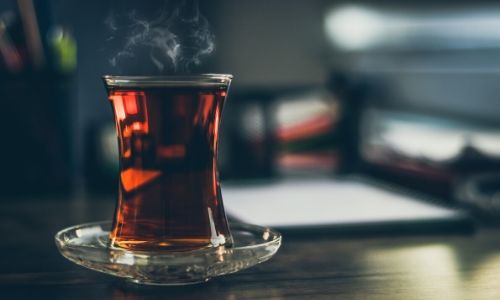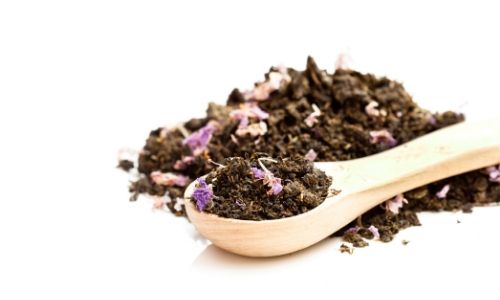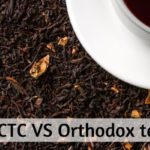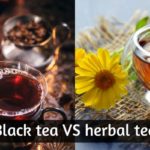Black tea seems to be everyone's favorite kind of tea. You might not know it, but most probably the tea you're drinking right now might be black tea.
This is because black tea is so common in the West it's just called 'tea'.
But if we love black tea so much, do we even know what goes into making a batch ?
How is black tea made even ?
Let's explore this for a bit, so we can also understand why there's so many kinds of black tea out there as well.
First, let's start by explaining what black tea is, so we're all on the same page.
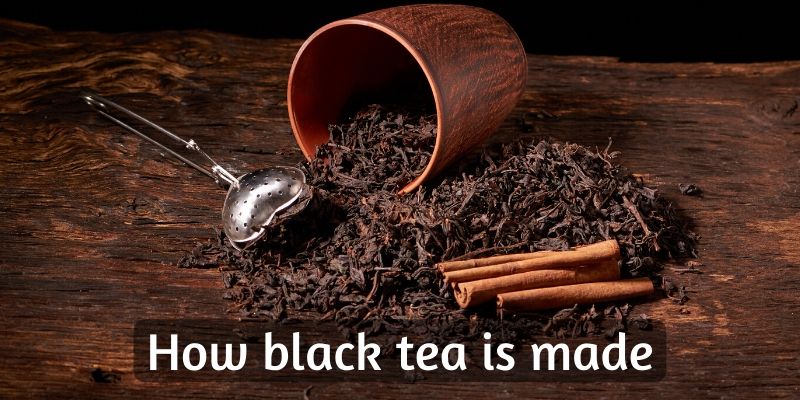
Table of Contents
What is black tea ?
Black tea is the drink made from the dried and cured leaves of the Camellia sinensis or Assamica plant.
These are the two tea plants that are most commonly used for black tea. The sinensis variety is the most common, the one the Brits first encountered when trading with the Chinese.
It's the same plant green tea is made of.
The Assamica variety is the one most Indian teas are made of. The name itself is drawn from the Assam region in India, where this plant is grown.
If you're looking to make an original Masala Chai, then you'll be needing Assam black tea.
Black tea differs from the other teas because:
- it's the most oxidized tea variety out there
- it's also subjected to more heat treatment
- has a distinct malty, earthy flavor
- turns out actually dark red/amber
If you're wondering why everyone calls it black tea when the brew turns out red/amber, it's because of the leaves. The way the leaves are processed, they become a very dark brown that's almost black.
Thus, black tea. If you ask the Chinese it's red tea, because of the brew color. Do not confuse this with Rooibos red tea, though.
Why are there two tea plants ?
There are two distinct (but very similar) tea plants because back the the British were expanding their territory, they came up with a plan.
They'd already gotten a hold of India, and were trading with China as well. The trouble was China had the monopoly on the tea market.
This meant that they could set the price as high as they wanted, and were also threatening East India Trading Company's profits.
So, the British decided they would use the land in Assam, India to grow their own tea for export. And the gave the land freely to whomever was willing to move there and grow tea.
Thus, the Assam black tea was born. It also became the main version of black tea imported in Europe, thorough the East India Trading Company.
Is there no Assamica green tea ?
Originally Assam tea was only black. This is because black tea was the main import and what most folks knew.
As time went on, people began experimenting with Assam tea. There is green tea, yes. There is also white tea,I think.
Butt they're much less common, because the Assam variety has a strong malty flavor that does not sit well with teas that are not black.
For this reason people are still tinkering with the recipe for any other tea version made from Assam tea.
Still, if you look hard enough you might just find some teas that are made with Assam tea and are not black.
Black tea manufacturing process
Alright, let's get to the meat of the post. The burning question.
How black tea is made, and how this entire process sets it apart from the other teas
Before we go on, I'd like to state that the process we'll be discussing here is the one applied for basic black tea. The most simple black tea possible, which all other recipes have expanded upon.
If you're looking for a specific type of black tea, know that the main process is very similar to the basic one. Any variations are going to be included in another section towards the end of this post.
So, let's start with the most important part, the plant itself.
Growing the tea plant
The tea plant is a sensitive thing. It needs a specific elevation and terrain incline.
Its main growth zones also coincide with the coffee plant. So that means elevations between 700 meters and 1500 are the most common both for coffee and tea.
However some tea farms have moved gradually up the mountain. It's possible to find teas grown at 2000 meters nowadays, and the higher the elevation the better the tea quality.
This is because high elevation means slower growth, and cooler temperatures. This makes the tea plant develop a more complex flavor, and also reduces the number of pests that one might have.
The downside to this is the amount of time it takes to grow the plant, and getting the workers up and down the mountain to pick the leaves.
This all results in a higher price tag for teas grown at a high altitude.
Another reason to care about where the plant grows: volcanic soil is more nutrient dense. This is why countries in the South-East part of Asia seem to grow the best tea.
There are plenty of active and inactive volcanoes in the ares, the the soil there is very rich.
A well grown tea plant will always mean a better tea. If you start off with a great base, you're going to get a great end product as well.
So the next time you take a look at the tea box, know that items such as location, elevation and (possibly) tea type really do have an impact on the overall quality and flavor of your tea.
Picking the leaves for black tea
Once the plant has grown, it's time to pick the leaves.
The tea plant is an evergreen, meaning it does not wither during winter. It does stop its growth however, and resumes in spring.
This is when the new growth starts to appear, and when it's important to pick the leaves if you're making white tea (with fresh, unopened buds).
But we're making black tea here, so the buds need to open and unfurl. This means the leaves must grow past their initial fragile stage and begin to develop the slightest hint of thickness.
Not too much, because they can grow very large.
But picking in early April is a good time to start with black tea. This is basically the first period that the leaves are young, unfurled, but still thin and small.
Only the top parts of the tea plant are picked, since that is the newest growth.
After each picking, the tea plant regenerates. It takes a couple of weeks for the new growth to show, and then it can begin to mature a little and is ready for another harvest.
Black tea is typically harvested 4 time throughout the year.
Towards the beginning of the year, floral and light fruity notes are more common. The plant is young and fresh.
Come the end of the year and monsoon season, the tea develops a malty, deep flavor and this results in different strains of black tea.
Perhaps the most famous and clear example of this phenomenon is Darjeeling tea.
This is a name you've surely heard before, along with the name 'flush'. That is another name for the new growth, and the first two flushes of the Darjeeling tea are considered premium.
Of the two, the second is considered to be the absolute best.
Processing the tea leaves
Once the leaves are picked, they are transported to large warehouses or yards to be oxidized and dried.
Oxidation is important because it brings out different flavor in the tea leaf. Of all the teas, black tea is the most oxidized. OF course, each black tea has various levels of oxidation.
This all depends on the tea master, who decide what kind of tea is best made from that particular batch of leaves.
The very first step is to dry the leaves out, before they are oxidized.
Once dry, they're ready to be processed.
Leaves must be oxidized, then dried
Oxidizing the leaves means breaking their structure by actually rolling them, bending them, but not crushing them. The aim is to simply break the walls of the inner cells of the tea leaf, but not the entire structure.
This makes the leaves develop their flavor faster, and bunching them all together will help speed this process as well.
The treatment is usually done in big vats or baskets that continuously turn the leaves and the end up hitting against each other.
Once oxidized, they're left to dry together in a well aired space. Sometimes they are air dried, sometimes they are left to dry in the sun.
They're not meant to dry completely, but rather reduce the moisture content a little and sit together a little.
Heat treatment is applied
Once the leaves are oxidized and the tea master is happy with the way it looks, it's time to treat them with heat.
This can be done several ways, such as pan-firing the leaves, or they can be introduced in an oven, arranged near a fire pit, or some other improvisation.
The most common is the oven method since it allows you to process lots of leaves at the same time.
The leaves aren't dried in this process, they're merely flash-heated. This locks in the current oxidation level and makes sure they can't change their flavor afterwards.
Once this step is done, the leaves are cooled.
Setting the leaves
While the leaves cool, they are very pliable and can be rolled or shaped as the tea version needs them to be.
So, this is the time when any tea balls or rolls are formed.
Once the tea is shaped, it's air dried with warm air to set it in place.
A word on CTC black tea
If you're unfamiliar with CTC it stands for Crush, Tear, Curl. This is a method of processing black tea much faster, though not all tea companies use it.
This is because it results in more broken leaves and tea dust.
The idea behind it is that right after picking the leaves and drying them a little, they're cut into smaller pieces. This makes the oxidation process go much faster, and there is no shaping or setting process required.
After oxidation, the leaves are heat treated and they're then allowed to fully dry out.
This is the most common way of producing tea that is meant for teabags, since very small pieces are needed.
These small pieces steep very quickly, resulting in a quick cup of tea for everyone.
The only downside to this is the lack of depth in flavor. Tea tends to be flat and malty, as opposed to a more complex flavor obtained through traditional methods.
Different black teas have slightly different processes
It might be that your favorite black tea has a slight twist to it.
For example smoked black teas are dried over an open fire, right into the smoke. This allows the leaves to pick up the flavors from the smoke and infuse your cup.
If you're thinking of flavored black teas, it depends on how those flavors are achieved.
For example Earl Grey is made using bergamot essential oil. Most often, the tea leaves are spritzed with a very light layer of essential oil after they've been oxidized.
This is the most common method for flavoring teas. If you were to add the flavor during the oxidation process, you would change the overall flavor as well.
Unless that's what you're looking for, and this allows room for a lot of experimentation.
As for the black teas that also contain bits and pieces of fruit or caramel or cinnamon, those rely more on the close contact between the tea and the flavorings.
So for example a black tea with cinnamon is going to draw its flavor from the cinnamon sticks it sits with in the vats, rather than being spritzed with cinnamon essential oil.
Conclusion
Black tea is made in a very interesting way, and there are so many little twists to how each company does things.
The end result is a wide array of options that you can choose from and easily find your favorite.
If you want to know more about coffee or tea, feel free to check the related articles below. Who knows what else you might find ?


